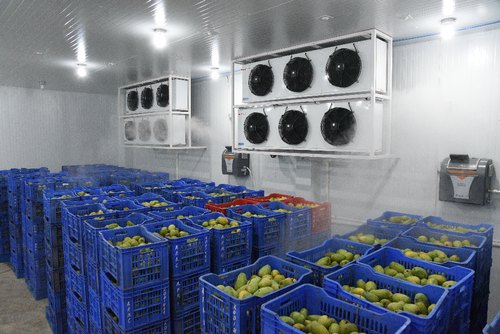การบ่ม ที่ทำให้ผัก ผลไม้สุกนั้นก็มีอยู่หลายวิธี ทั้งวิธีธรรมชาติ และการใช้เทคโนโลยีเข้าช่วย การผลิตผัก ผลไม้ป้อนเข้าสู่ตลาดในปริมาณมาก ก็จะนิยมใช้เทคนิคทางวิชาการเข้าช่วยเพื่อควบคุมให้ได้สินค้าที่มีลักษณะใกล้เคียงกัน ซึ่งมีผลต่อราคาขาย และการคงอยู่ของสินค้าก่อนถึงมือผู้บริโภค วิธีที่นิยมมากก็คือการใช้แก๊สเอทิลีน เป็นตัวช่วยในการเร่งสุก โดยการปรับสภาวะในห้องบ่ม ให้มีความเข้มข้นของเอทิลีน C2H4 ประมาณ 1,000 ppm (หรือ 0.1% volume) และเมื่อผัก ผลไม้เริ่มสุก ก็จะคายแก๊สคาร์บอนไดออกไซค์ออกมา หากปริมาณ คาร์บอนไดออกไซค์ในห้องบ่ม มีปริมาณเกิน 1% (หรือ 10,000 ppm) ก็จะส่งผลให้กระบวนการนี้ช้าลง ดังนั้น การคอยตรวจสอบปริมาณแก๊ส ทั้ง เอทิลีน (C2H4) และคาร์บอนไดออกไซค์ (CO2) ในห้องบ่มผัก ผลไม้นั้น จำเป็นอย่างยิ่งในการควบคุมคุณภาพสินค้า
สรุปประเด็นสำคัญ
- ผลไม้และผักมักถูกขนส่งเป็นระยะทางไกลก่อนที่จะสุกและจำเป็นต้องได้รับการบ่มเพื่อให้สุกและพร้อมสำหรับการขายและบริโภค
- เอทิลีนเป็นสารกระตุ้นการเจริญเติบโตตามธรรมชาติที่ช่วยเร่งกระบวนการสุกของผลไม้และผัก
- ในห้องบ่มผลไม้ จะใช้เอทิลีนในปริมาณที่ปลอดภัยต่อมนุษย์ อย่างไรก็ตาม เอทิลีนเป็นก๊าซที่ติดไฟได้ง่าย จึงเป็นปัญหาด้านความปลอดภัย
- มีสองวิธีทั่วไปในการเติมเอทิลีนในห้องบ่มผลไม้ คือการใช้ถังแก๊สแรงดันสูงหรือเครื่องกำเนิดเอทิลีน หากใช้ถังแก๊สแรงดันสูง ควรมีการตรวจสอบความรั่วไหลของก๊าซอย่างสม่ำเสมอเพื่อป้องกันการระเบิด

Fruits and vegetables are commonly shipped for long distances from one country to another before they are ripe so they can endure the voyage and remain viable. Upon arrival at their destination, the first order of business is to get them ripe and ready for sale and consumption.
As fruit and vegetables ripen, they release ethylene, a naturally occurring growth hormone. To be profitable and meet demands, commercial fresh produce companies need to speed up the ripening process in a uniform and predictable way, which is achieved by adding more ethylene in a controlled environment. Typically, the fresh produce is placed in air‐tight ripening rooms and ethylene is introduced at concentrations between 10 and 1,000 ppm depending on the type of produce. Ethylene is not harmful to humans in the concentrations used in ripening rooms. An extremely high level of ethylene would have to be inhaled in order to have an adverse effect on human health. That being said, ethylene is a very reactive and flammable gas, making the potential for an explosion a safety concern. The LEL for ethylene is 27,000 ppm (2.7%) and a common concentration used in a ripening room is 1,000 ppm (0.1% by volume), with a typical exposure time of 24 hours. Two common ways to add ethylene to the ripening rooms is by high pressure gas cylinders or ethylene generators. If ethylene is delivered into the rooms by pipes from cylinders, there are areas for potential leaks and the threat of explosion from cylinders of pure ethylene is high.
We have Analog Transmitter with an electrochemical Ethylene sensor would be highly recommended to continuously monitor the ethylene gas levels in the cylinder storage room. The information gathered by the sensor is viewable on the LCD display of the transmitter. If a leak is detected, the relay can quickly switch off the gas cylinders or ethylene generators. In the ripening rooms, the primary reason for an ethylene gas detector is not for the safety of humans, but rather for the safety of the perishable goods. Assisted ripening is a complex process and predictions can be made about the remaining shelf life of the perishable goods based on the level of ethylene gas that is present; that the produce gives off. Some types of fruits and vegetables are more sensitive to ethylene than others. Ethylene sensitive produce will spoil if exposed to levels that make them ripen too quickly. Varieties that are more tolerant but don’t get the right amount will not ripen on schedule. There is also the potential for ethylene to leak from one room into another, especially if the method of delivery is through a network of pipes. This could cause premature ripening or result in damage to the other types of produce in adjacent rooms. Monitoring the concentration levels of the ethylene gas in each room will help ensure the correct amount is being delivered at all times.
As fruit ripens, it releases carbon dioxide. This decreases the oxygen level in the room and delays the effects of the ethylene. CO2 levels in excess of 1% (10,000 ppm) will slow the ripening process, and can cause quality and production problems. When CO2 levels build up, the ripening room should be vented, which could be as simple as opening the door, or turning on a ventilation system. Constant monitoring of the CO2 levels inside the room is essential. We also have Industrial CO2 Transmitter with a nondispersive, infrared CO2 sensor that can be configured to activate the ventilation system at a predefined concentration allowing for a more efficient control and optimization of the

